THE SACRED ANGLES OF ORION AND THE GOLDEN NUMBER IN THE ARCHITECTURE OF THE IV DYNASTY:
DEVELOPMENTS OF THE ARCHAEOASTRONOMICAL RECONSTRUCTION OF ROBERT BAUVAL
To Antonio: to have been close in the harshness,
the sweetness and in the abysses of this research.
– C’est vrai ; c’est à l’Éden que je songeais!
Qu’est-ce que c’est pour mon rêve, cette pureté des races antiques!
A. Rimbaud
1) Aim of the present article is to add some pieces to the big archaeoastronomical mosaic with which Robert Bauval has reconstructed the theological-astronomical meaning of the IV Dynasty Pyramids; making reference to a so famous work, maybe we could take for granted that anyone who is interested in archeology and Egyptology is acquainted with it. Anyway, we will offer a brief resume of Bauval’s ideas, so that also the reader that for any reason would not know them will be able to understand the meaning of this article. Robert Bauval, in his best seller “The Orion Mystery” theorized that the Pyramids of Giza and Dahshur was an image of the Duat sky in a date around the 10500 BC. The three Giza ones and other two very less famous Pyramids would have been the terrestrial counterpart of Orion, while the two Dahshur ones would represented the two brightest stars of the Pleiades. The natural point of reference of this big sacred landscape would have been the Nile, intended as a terrestrial avatar of the Milky Way. The below image gives us a visual idea of the archaeoastronomical reconstruction of Bauval, with on the left the Duat sky in the 10500 BC and on the right its terrestrial counterpart.
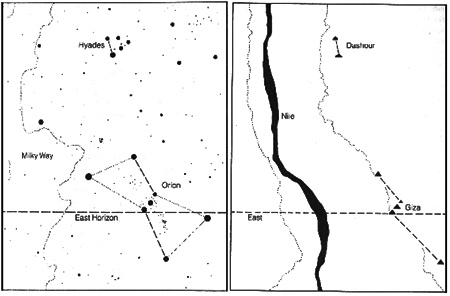
As everybody knows, this is, so to speak, the “widened version” of a first intuition, in which the layout of the three Giza Pyramid was seen as an image of the position of the three stars of the Orion Belt in the same date, intuition that followed the Alexander Badawy and Virginia Trimble’s, that the southern shaft of the King’s Chamber in the Great Pyramid was targeted on the Belt of Orion at the passage on the meridian in a date around the 2600 to 2400 BC (Bauval later discovered that the other shafts too have a similar astronomical meaning). And precisely Alnitaki – as we can immediately notice observing the below image on the left – is the Orion Belt star of which the Big Pyramid is the counterpart in its architectonic image.
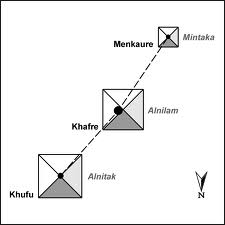
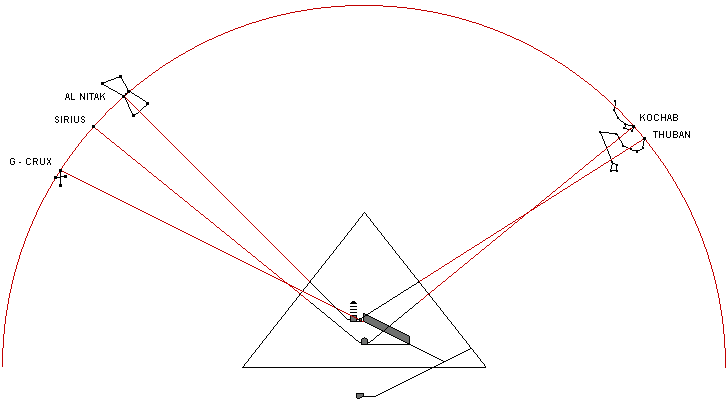
Furthermore, if we overlap the angle virtually traced by the three star of the Orion Belt in a date around the 12000 BC, as we are going to see in the following image, we will notice an almost perfect alignment with the profile of the Big Pyramid and, considering that the Giza Plateau is a reproduction of this same horizon, we can also note that the layout of the three Pyramids has important points of correspondence with the profile of the internal structures of the Big Pyramid itself. Actually, the diagonal of Khafre Pyramid seems to coincide rather precisely with the inclination of the southern shaft of the King Chamber

2) On the basis of these facts the Bauval Orion Connection Theory seems – if not indisputable – absolutely reasonable, as the complex architectural structure of the IV Pyramids Dynasty – with its marvelous plot of astronomical orientations and geometrical proportions – does not appear the fruit of a mere chance, or of the uncoordinated will of three different Pharaohs: also an uncultivated eye can sense a general project. To maintain the contrary opinion should be as to maintain that the 3 parts of the Divine Comedy consist of 33 parts made by 33 terza rima independently from a general plan in which the 3 had a fundamental importance. In spite of this, the Bauval theories was very discussed and also violently contrasted, but now in this article we can add to the astronomical proofs that he himself have found some other ones of a geometrical kind, and we believe that these proofs will clear out any doubt about the question of the connection of the IV Dynasty Pyramids with Orion. In fact, in the figures that follow we can observe that the characteristic angles of the Giza and Dahshur Pyramids have an undoubtedly and intimate connection with those of Orion and with the whole of the Duat Sky. Let’s begin with the Big Pyramid.


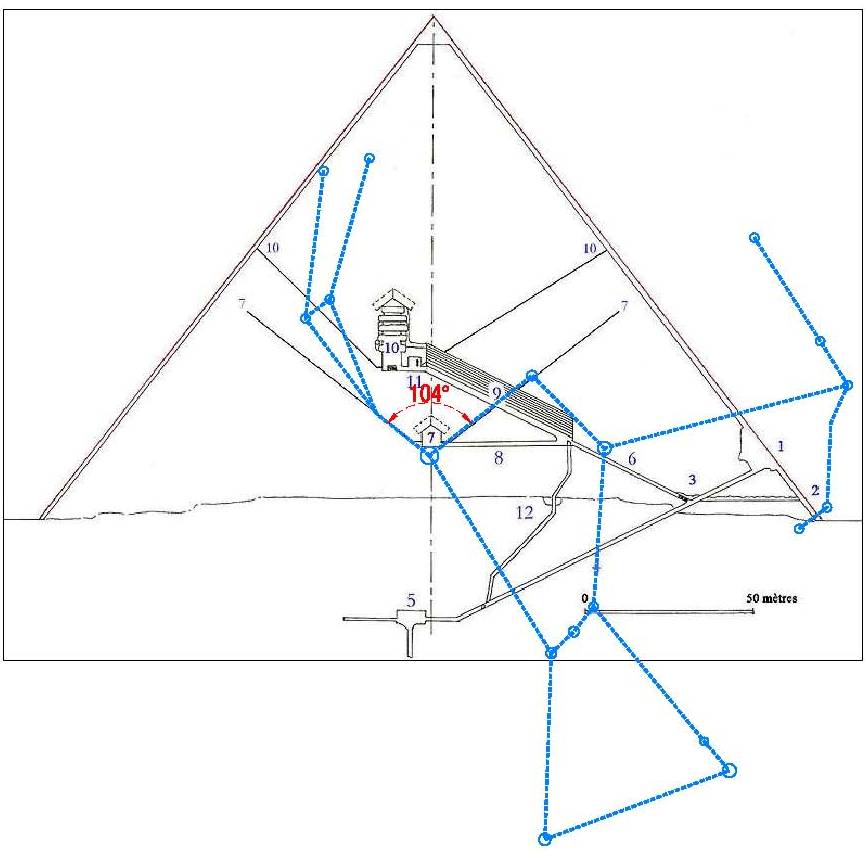
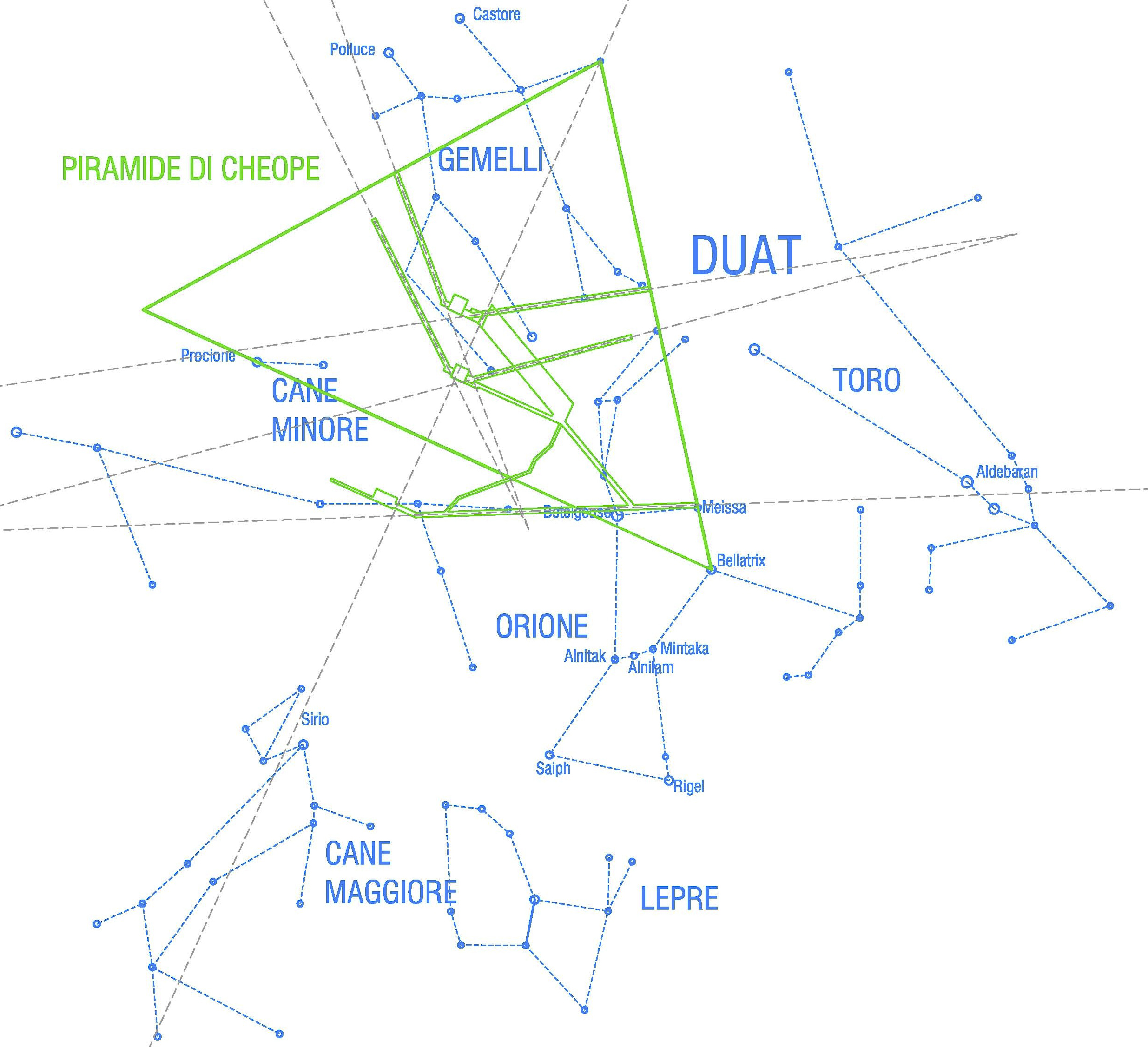
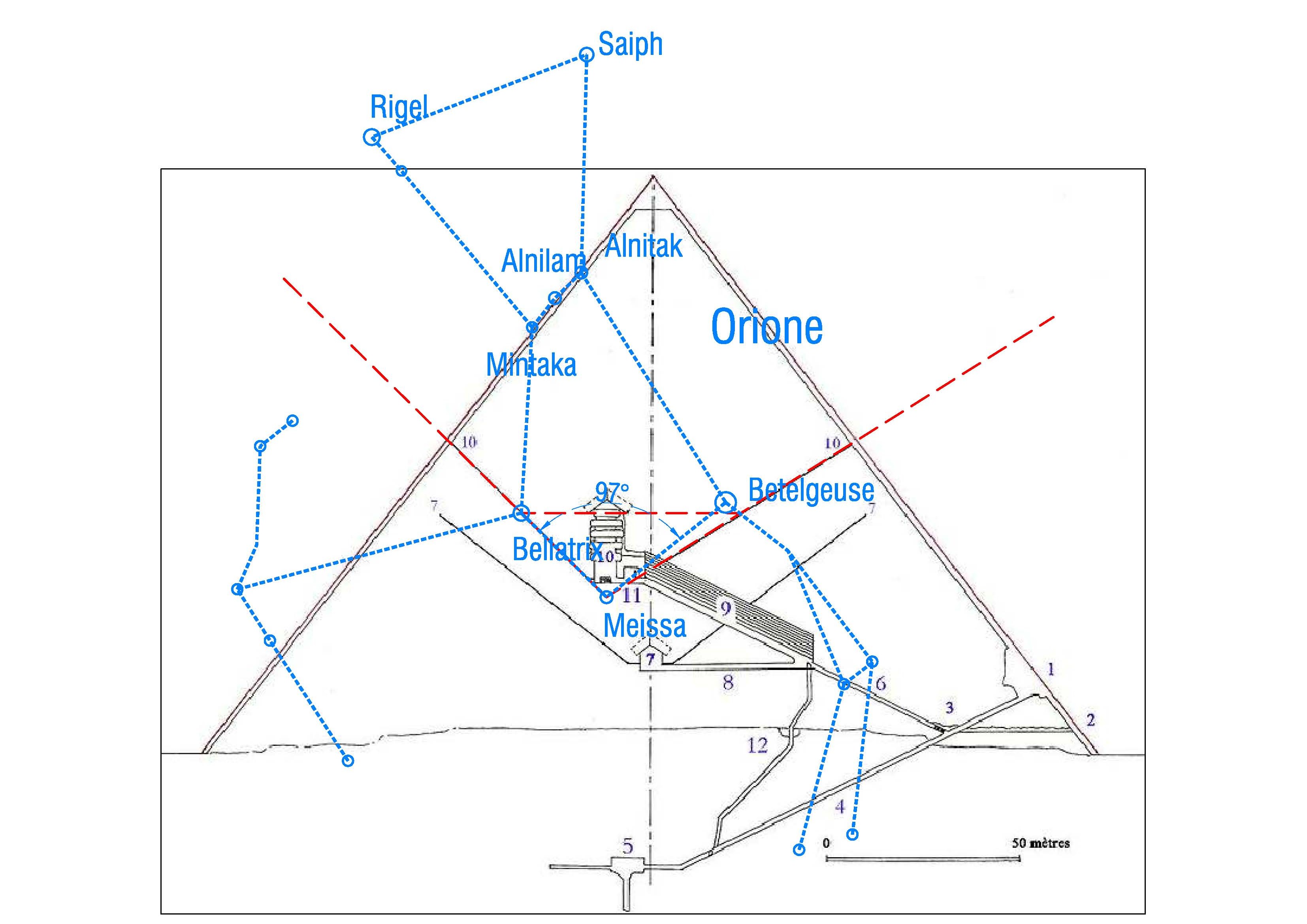
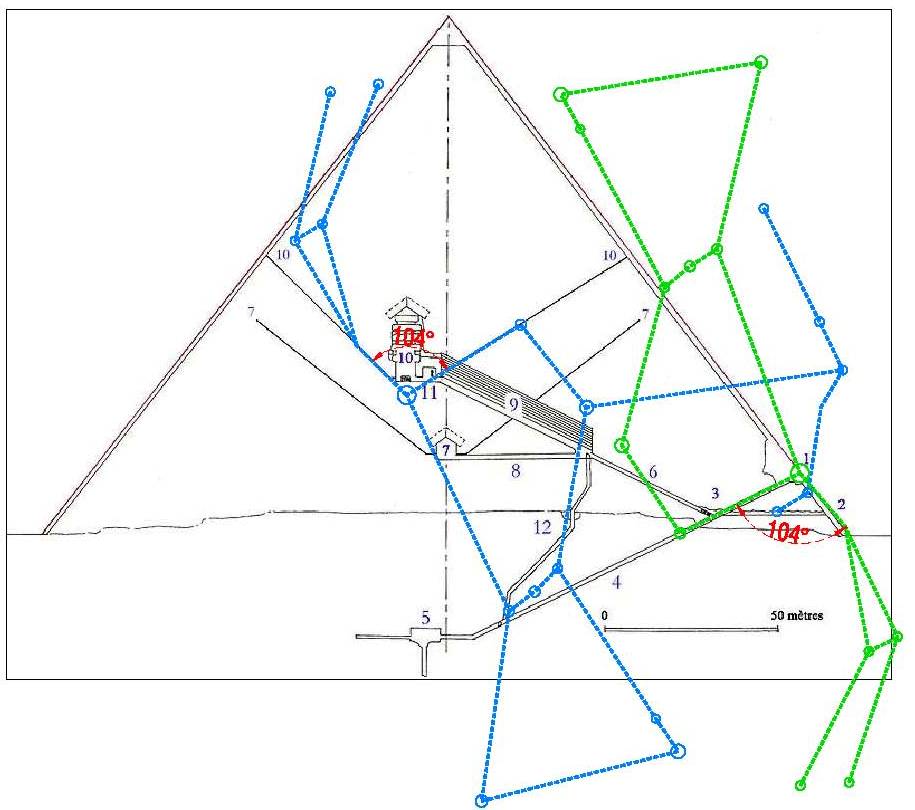

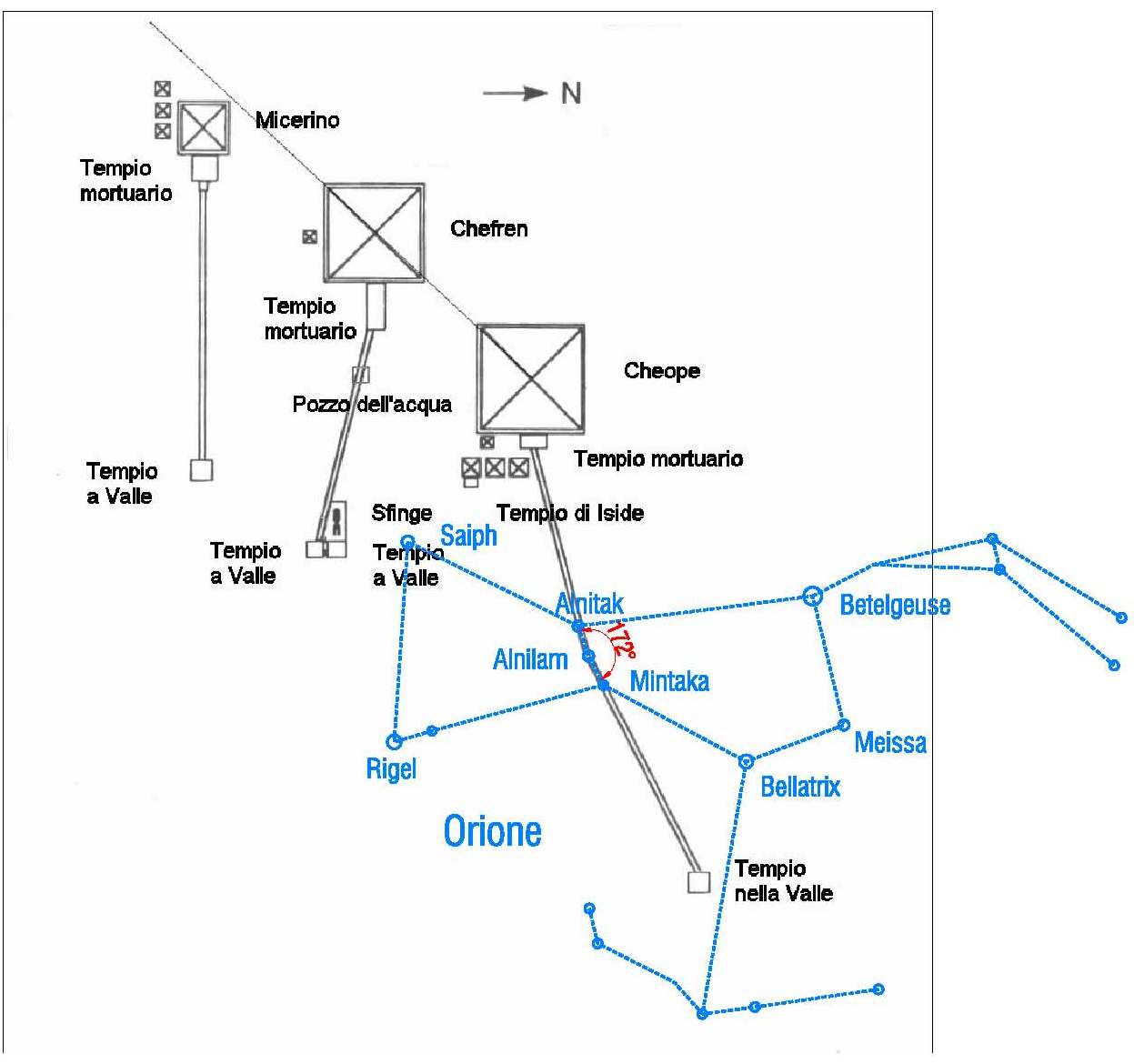
To believe that all this system of overlappings between the angles and the proportions of Orion and the angles and the proportions of the Big Pyramid is a system of coincidences is simply out of the commonsense. Furthermore, we can note that one of the angles more “used” by the Ancient Egyptian architects to project the Big Pyramid is precisely that of 104 degrees, the one between the right “shoulder” of the goddess-constellation and that which is usually interpreted as his “raised arm”, symbol of his renewed power and resurrection: and it is precisely to the eternal life, to the “life lasting millions of years” that was aimed the cult of the Ancient Egyptian monuments of any epoch. If we go on with the analysis of the structures of the other Pyramids of the Plateau, we find that also Khefren and Menkaure internal structures show many times an intimate connection with the Orion angles. The image of Menkaure – in the second line at the right – is incomplete, in the sense that does not underline the fact that the angle Meissa-Beltegeuse – if Orion were drawn with another scale – would coincide with that of the angle at the base of the Pyramid. That means that the whole of the profile of the structure of this Pyramid follows the same pattern of the entire left side of the Orion body.


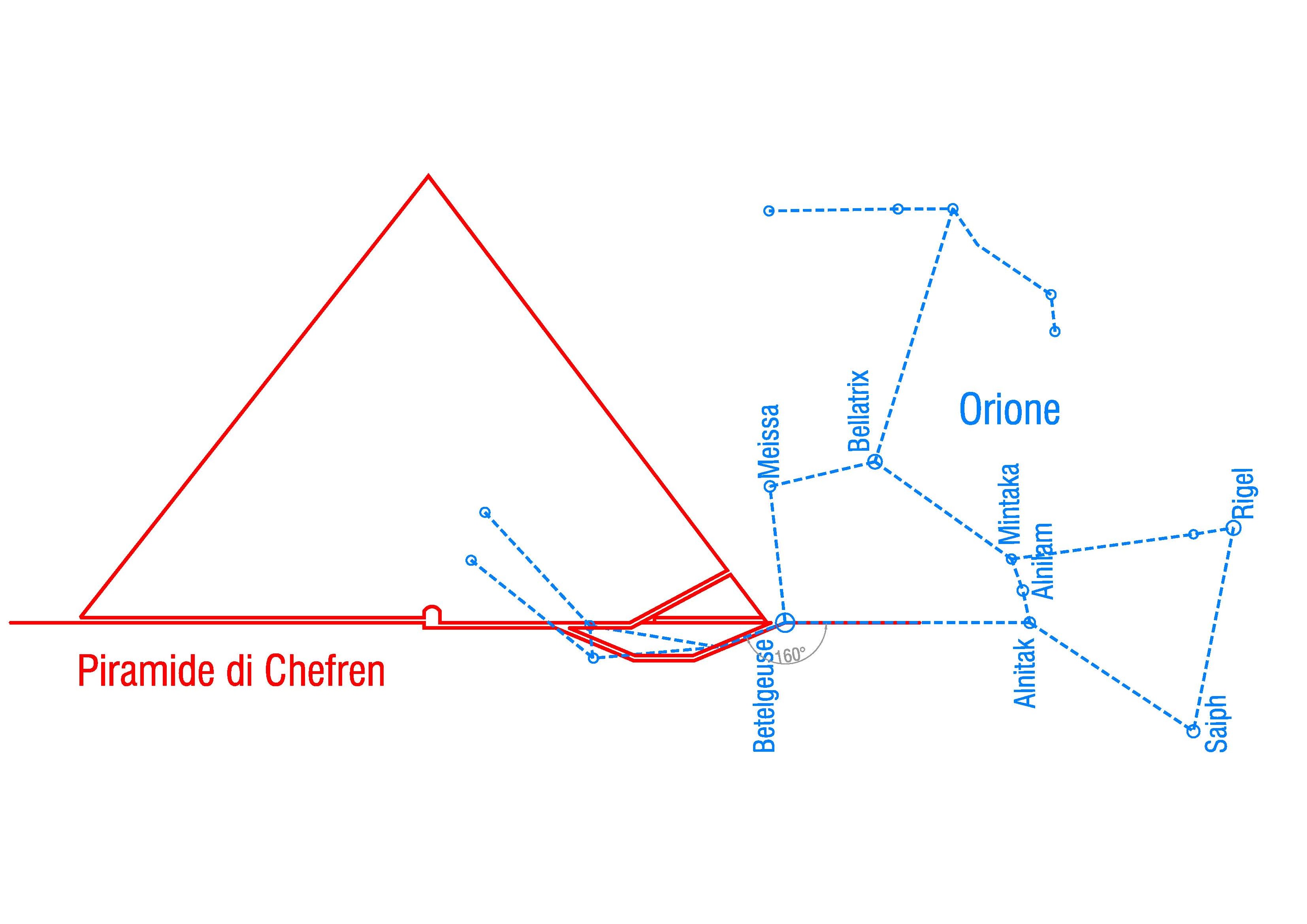

If now we move from Giza to Dahshur we find that the structure of the Bent Pyramid too shows many times very close connections with Orion, and, just like in the case of the Big Pyramid, the slight inclination of the road toward the valley temple is again the same angle of the Belt (the other Dahshur Pyramid, the Red Pyramid – as we are going to see – has with Orion a less immediate geometrical connection; but this does not mean that this connection is less meaningful, because its characteristic angles are connected with the Nabta Playa Stone Circle, where the ancient astronomers-priests marked at least the two extreme points touched by Orion during the 45°- 47° of oscillation of a precessional semi cycle lasting about 13000 years).
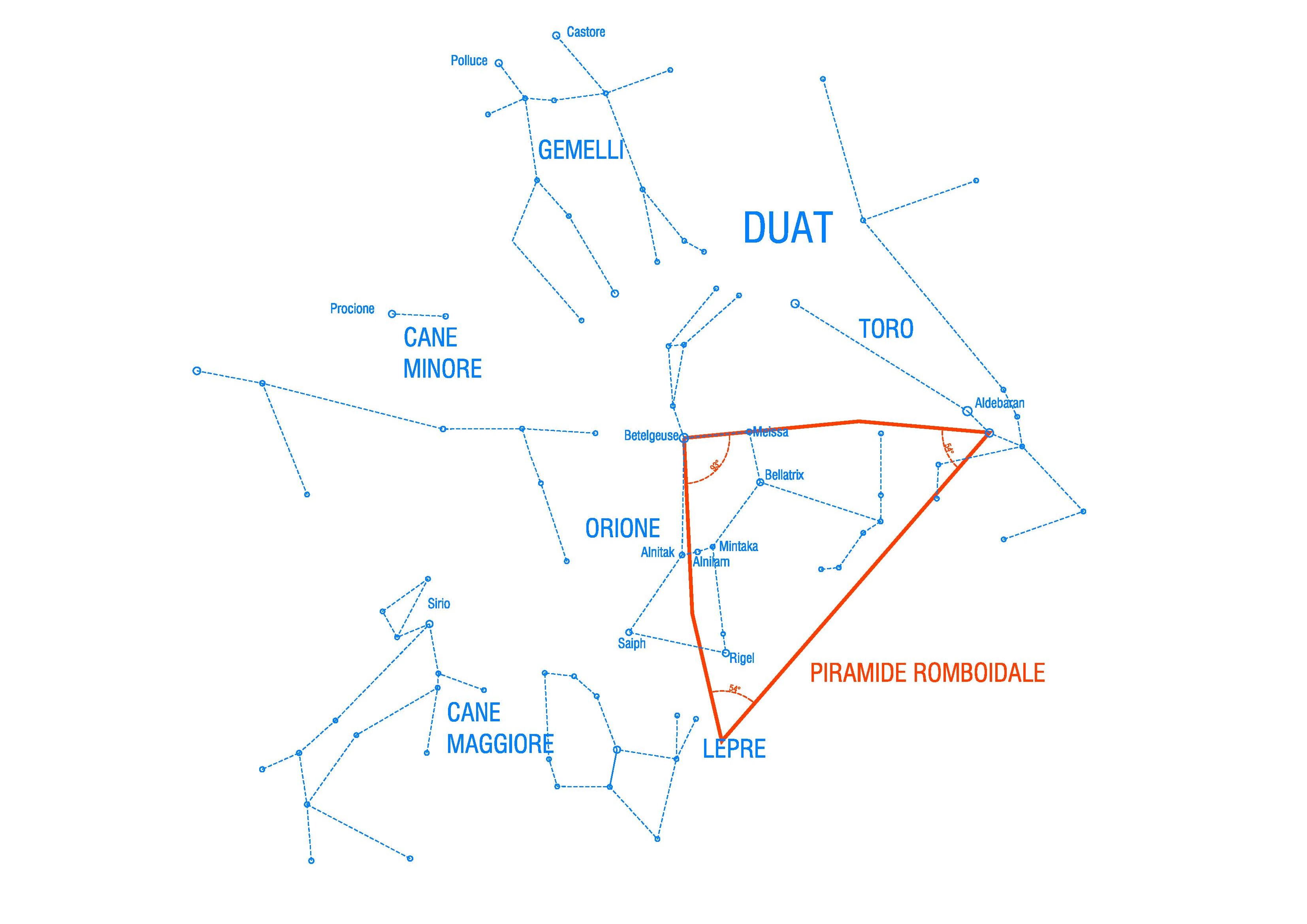


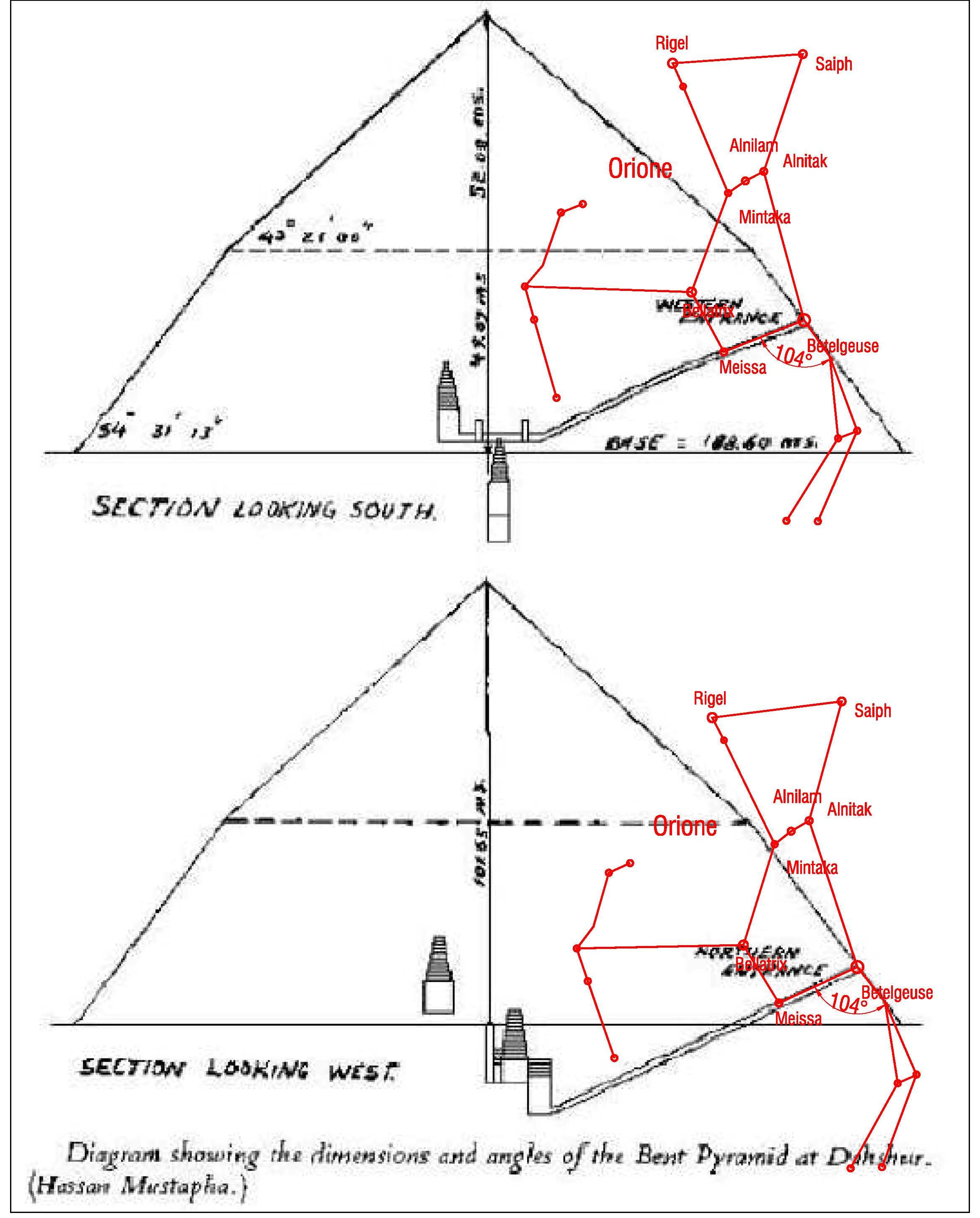
This system of geometrical consistencies goes on also if we turn our attention to the design of the Plateau as a whole. As we can see in the below images, Dahshur seems to follow in the disposition of its structure a system based on the characteristic angles of Orion in a less evident but no less deep way than Giza.

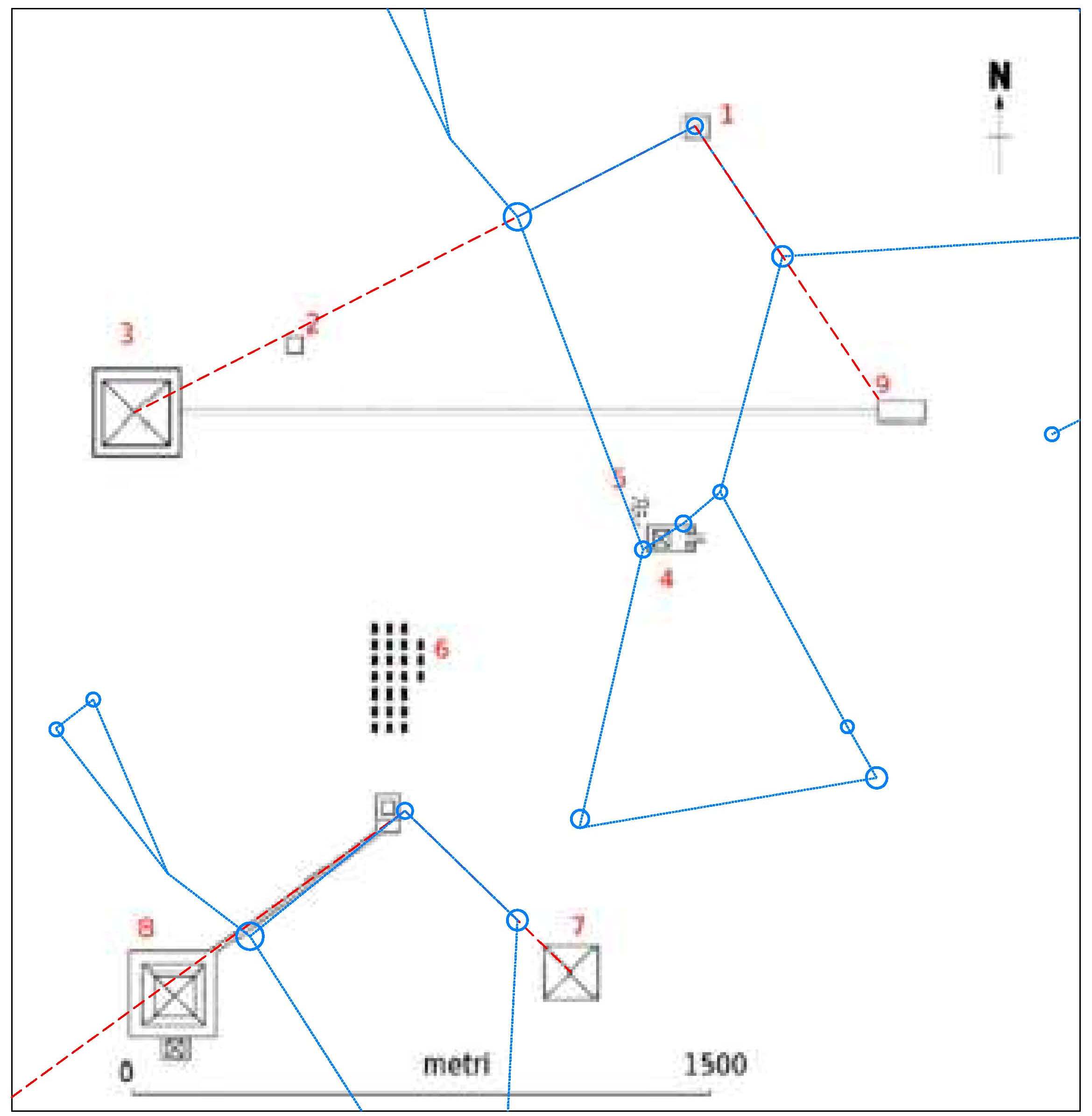
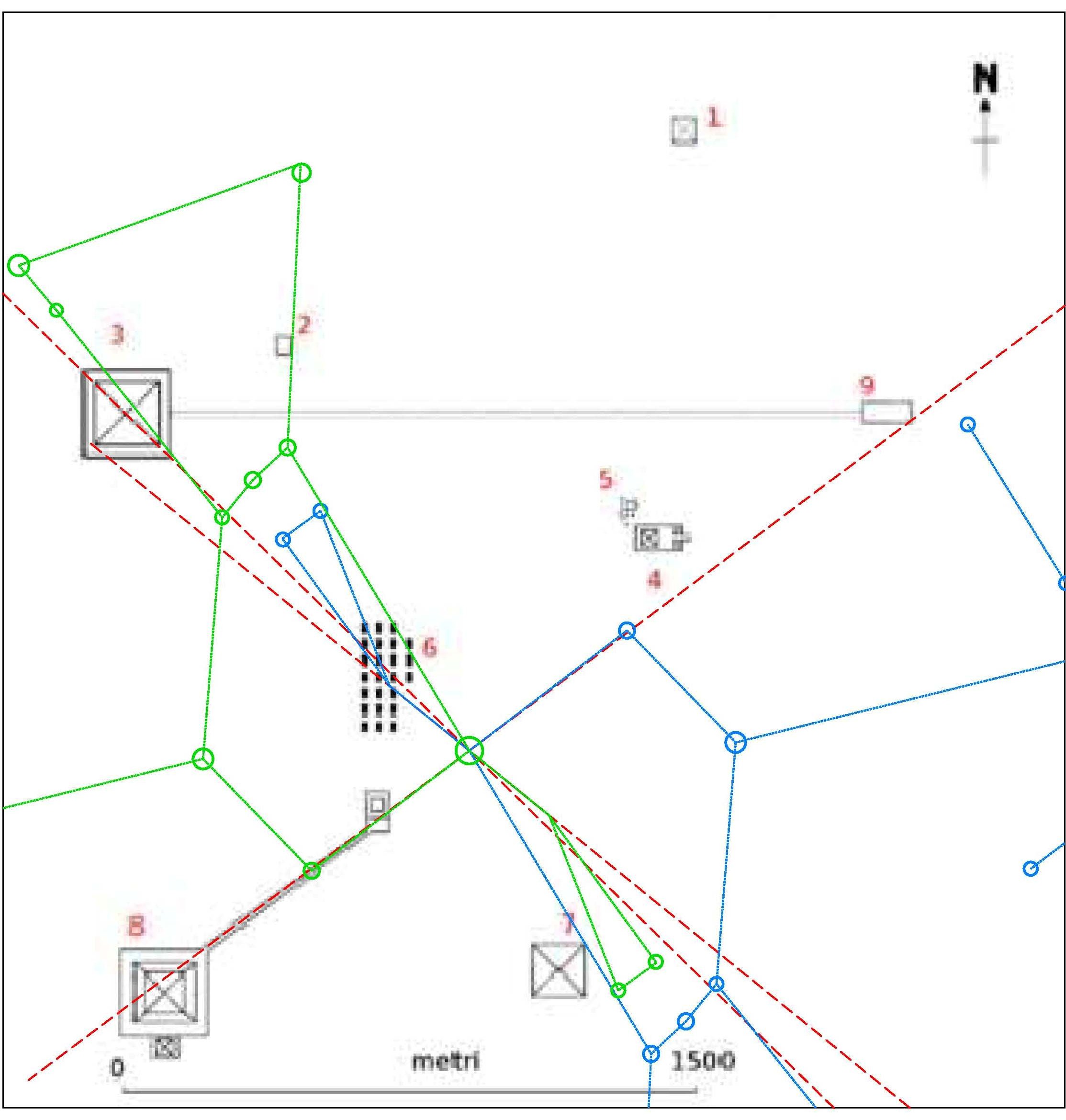


Also in the design of other Pyramids, far less famous than those of Giza and Dahshur, we can find the characteristic angles of Orion: the descending corridors of the Djoser and Neferikara Pyramids and that of Meidum have geometrical consistencies with Orion Shoulders, whereas in the case of Sekhemkhet – just like in which of the Red Pyramid – we will find the geometrical connection with Orion with the mediation of the characteristic angles of the Nabta Playa Stone Circle.

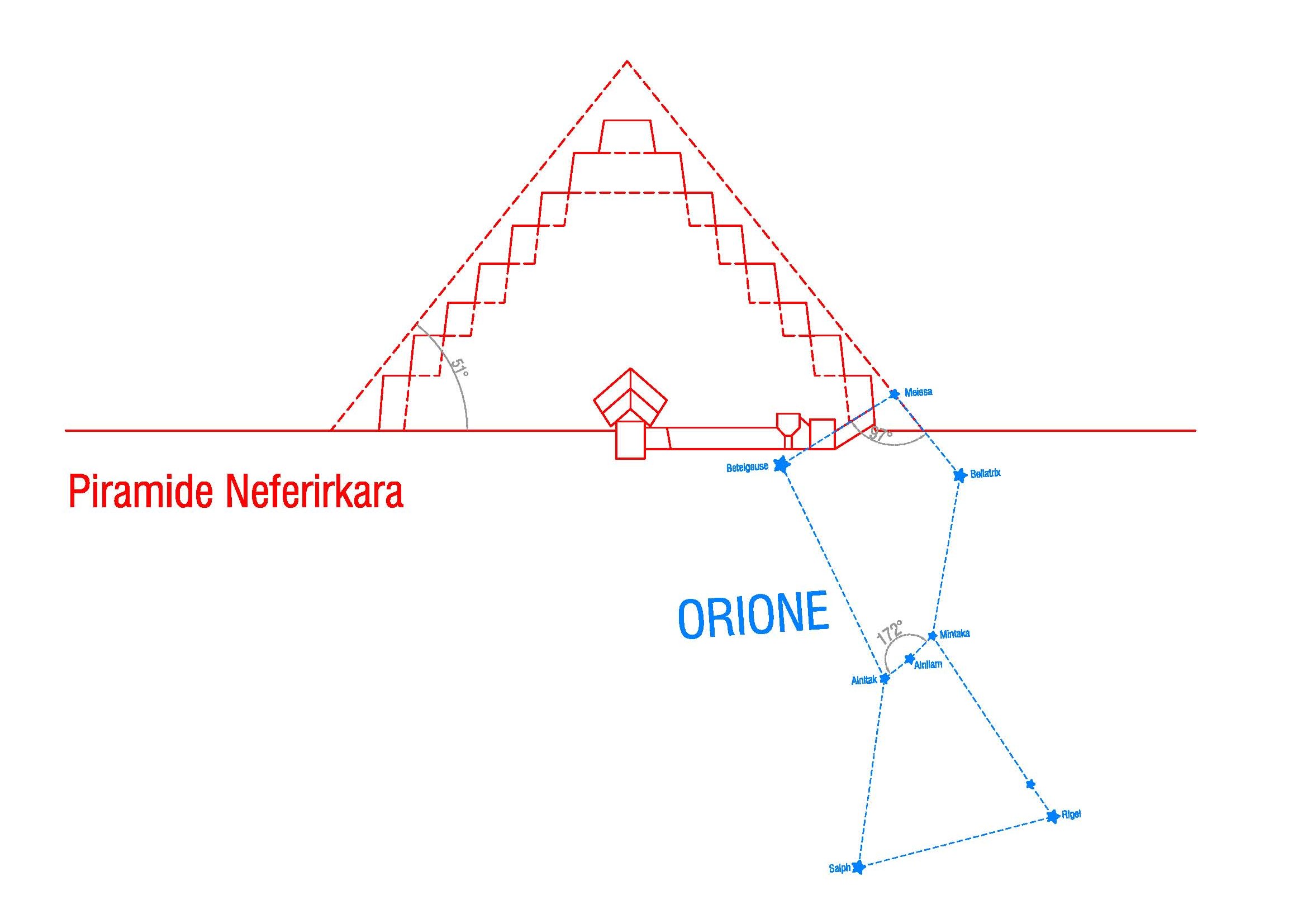

3) The Nabta Playa Stone Circle is situated on the southern part of the Egypt, rather distant from the Nile. It’s believed that it is a work of a nomad community of the Neolithic, that would have operated there between the 6000 and the 4500 BC. The astronomer Tom Brophy has discovered that the Circle – that is part of a much complex megalithic system – contains the indication of the position of the Orion Shoulders and Belt respectively in the 16500 and 4900 BC.

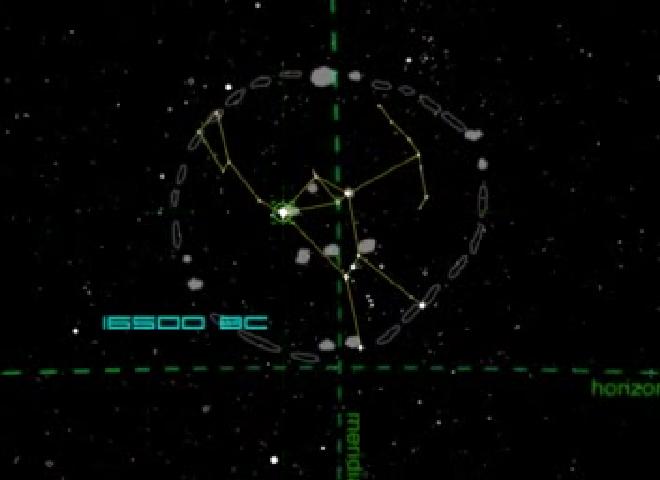
But, from our point of view, the Brophy interpretation contains a little error, in the sense that the oldest date marked by the stones of the Circle is not the 16500 BC but, as it seems more natural too, the 18500 BC. In fact, if we go on following the oscillatory movement of Orion until that date and at the same time we reduce the dimensions of the constellation – as Brophy did in his book and in that documentary from which we have taken the above images – we find that kind of geometrical consistency that we can see in the below image.

Now, observing the images that follow, we are going to discover with astonishment that this neolithic community with its “rough” stone circle not only demonstrate a perfect knowledge of the precessional cycle, but, far more important, to operate in a complete astronomical-theological concordance with the Pyramid builders, people who are usually believed operating about three millennia later then the builders of Nabta Playa. Actually, the descending corridors of the Red and Sekhemkhet Pyramids overlap in a perfect way with the fundamental angle of the Circle, that it’s obviously that between the North-South axis and the axis traced by the sun at the dawn of the summer solstice. Furthermore, another time from the images that follow, we are going to see that the Red Pyramid with its base angle of 43,3°, shows a very interesting connection with the angle at the base of the Circle, that with the plan of the horizon forms an angle of about 137° (and so, with the North-South axis, another of about 47°). We note, as we did in the precedent article, that 137° result to be with a good approximation the reciprocal of the golden ratio of the circle, as the about 47° corresponds more or less to the section of arc completed by the Earth during the 13000 years of a semi cycle of precession (we recall that in 26000 years of a complete cycle the apparent movement of the stars at the horizon is for one half ascending, and for the other half descending)1.




——————————
1 On the connection between the golden ratio, the precessional cycle and the Ancient Egyptian sacred art and architecture see the precedent article THE GOLDEN NUMBER IN THE ANCIENT EGYPTIAN SACRED ART AND ARCHITECTURE: AN ARCHAEOASTRONOMIC PERSPECTIVE.
In the above image on the left we can see very clearly that the Red Pyramid, just like Bent and Big Pyramid do, has a rather direct connection also with the Duat sky as a whole (that, we recall, to the Ancient Egyptians was a sacred resurrection place) and not only with Orion, as its profile, included that of the internal structures, beside to lean on Orion, also get to touch one of the brightest stars of the Bull and with one star of the Hare.
4) At the end of the analysis of this long series of images we believe that we can state to have shown another very relevant proof that the IV Dynasty Pyramids were not built to be the tomb of a single Pharaoh, but instead to be a geometrical-mathematical symbol of Osiris-Orion, its terrestrial esoteric image. This symbolic connection does not remain only at the level of a geographical disposition, as it was largely discussed and demonstrated by Bauval. In contrary, the connection between Orion and the IV Dynasty architecture was introduced also in what we could call the angular code of their structures, based first of all on the Sacred Angles of Orion, and secondly on those formed by Orion itself with other stars of the Duat. To build structures with the characteristic angles of Orion – from the point of view of the Ancient Egyptian priests-astronomers – meant to incorporate symbolically into them the goddesses represented by Orion itself, that’s to say Osiris. And this was a further magical-symbolical instrument to take the Sky on Earth, that’s to say another way to make real and true the saying “so in the Sky so on Earth”. Then, to this point it is still more reasonable to think that with the name “Upper Egypt” Ancient Egyptians did not intend the southern part of their country, but the Duat Sky as it is possible to observe it watching south, more or less at the moment of the summer solstice. The “Low Egypt” would be its terrestrial counterpart that reflects itself on it – for instance – by means of the reciprocal disposition of Pyramids and in relation with the Nile. Furthermore, it is demonstrable that Pyramids were not built only to be in connection with the night sky, because we have proofs that this same connection existed with the sun and the daytime. This connection was assured first of all by the orientation of the structures with the cardinal points, with the East side pointing to the dawn and the Western to the setting of the two equinoxes, and with the roads to the valley temples pointing to the fourth of intersection between solstices and equinoxes in the case of Khefren and Cheops, and to the equinox in the case of Menkaure. Furthermore, about fifty years ago was casually discovered that the Big Pyramid was built so that at the dawn and at the sunset of the two equinoxes one half of the North and South facades was completely enlightened, while the other half remained completely obscure.
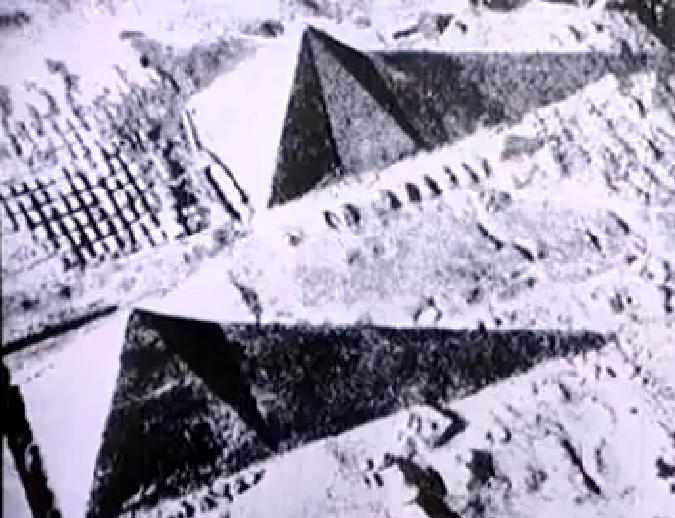
As we can see in the above image, the Big Pyramid only apparently has four sides: actually the sides are eight, as we can see even better in the image below..

It is clear that this little inclination to the internal side of the four facades it is not due to chance: it was intended to add another astronomical-theological meaning to the structure. During the equinoxes the dark and light hours last exactly the same time, and the Big Pyramid, as stone avatar of the celestial rhythms, incorporates in itself by means of the drawing of its structures the characteristics of the celestial entities of which it is the symbol. Being a solar symbol too – not only a stellar one – it was built so that at the dawn and setting of the equinoxes it becomes half dark and half bright, as the sky will be in those days, one half dark and one half bright.
5) To this theological-astronomical mosaic we can add other very meaningful and important parts. In “The Orion Mystery” – talking about the astronomical meaning of the South shaft of the King Chamber – Bauval says that the culmination of Alnitaki on the meridian – from the point of view of an observer placed at Giza in the 2500 BC – had a declination of about 45°. Today this same point is arrived to 58°06’, but we are not still get to the top, that will be reached in the 2500 AC, and will be equal to 58°14’. We have to note that this angle corresponds in an almost perfect way to the opposite angle of the major cathetus of a right-angle triangle which cathetus had a measure equal to the golden ratio. This kind of triangle has the major cathetus equal to 0,618033… and a minor equal to 1 – 0,618033… = 0,381966…; with those measures the angle opposite to the major cathetus results very near to 58°14’. The diagonal of this particular triangle is equal to 0,726542; curiously, the angle formed by a line traced crossing the tip of the Big Pyramid and that of Khefren with the North-South axis in South-West direction – taken with CAD from an usual map – turns out to be 46°35’-46°40’: the sine of this angle is, what a chance, about 0,7265, that obviously is equal to the cosine of 43°30’-43°40’, that is the base angle of the Red Pyramid. The medium of the South-West angle formed by the three Pyramids is about 52°20’, and it was reached in a year around the 12000 BC: it is spontaneous to bet that the exact year would be the 12125 BC, that correspond to the 10500 BC – the date of the end of the precessional semi cycle – plus 1625 years, a cipher that corresponds to one eighth of the about 13000 years of a precessional semi cycle and, numerologically speaking, not only to a number very similar to the golden ratio (1,618…), but obviously also to the ratio between 8 and 13, the seventh and eighth members of the Fibonacci sequence that probably had a big part in the whole of the mathematics and science of the people who built the IV Dynasty Pyramids. And it is very stimulating also to recall that if we divide the circle in 365,25 parts – as the days of the solar year – instead of the usual 360°, we discover that 52°20’ would be almost exactly one seventh of this strange kind of circle. We recall that 1/7 in ciphers is 0,142857…, a number very near to 0,145898… so (1 – Φ)³; that the angle of 52°20’ result in a rather exact way from 360° divided four time by Φand that the exact length of one year, that’s to say 365, 25 days results in an almost perfect way from 360 + (2Φ²) = 260 + 5, 236 = 365,236 (365,25/Φ⁴ = 53,289: the inclination of the Khefren Pyramid is of 53,167°). All this kind of connections that to us are very strange should not amaze ourselves too much, as the IV Dynasty Architecture seems to be everywhere characterized by very peculiar numeric and numerologic relations. Everybody knows that the base angle of the Big Pyramid is 51°52’, but few people are aware that at a numerological level this number corresponds to Φ/π = 1,618 : 3,14 = 0,515286… (if we take away the zero, the first four numbers correspond perfectly), and that the sinus of this angle is very near to the square root of Φ ( that is equal to 0,7861…: the sinus of 51°52’ is more or less equal to 0,7866). To this point, maybe no one will be astonished discovering that the relation between the sinus of the point of maximum declination of the moon (28°,6) and the sinus of the base angle of the Pyramid of Menkaure is very near to the golden ratio, as 0,4784 : 0,7808 = 0,612…
We are aware that some of these connections that we have just enumerated could be matter of discussion, but, anyway we have probably discovered that a reason why Giza was chosen as the place to build the three Pyramids is that from this point of observation Orion reaches its point of culmination at the meridian along the direction of an angle of a right-angle triangle built on the basis of the golden ratio. This fact confirms for the hundredth time not only the almost futuristic ability of Ancient Egyptian architects and astronomers, but also the enormous importance that the golden ratio had in each particular of their sacred buildings, so that to this point we are absolutely legitimized to doubt that the orientation of the so called air shafts of the King and Queen Chamber could have really something to do with the date of their construction. Actually, is precisely on the basis of the orientation of those shafts that the archaeoastronomers have thought that the Big Pyramid would be built, as we have already said, in a date around the 2500 BC. If we have a look between the many attempts of “exact” dating we find, for instance an “about 2465 BC”, that could be very interesting. Actually, no one has never inquired if this date to which the Great Pyramid alludes could have some kind of meaning that to this moment has remained unknown, together with the deep reasons of the spirit of the people who built it. Bauval says that Orion got to the minimum at the horizon – from a point of observation situated at Giza – in the 10500 BC. If we make the difference between this date and that indicated by the shaft of the Big Pyramid we find that 10500 – 2465 = 8035. This is a very interesting number, because if we make the golden ratio of a semi precessional cycle, we find that 13000 x 0,618033… = 8034,429 (we recall that 13000 years is the time occurring to a star to oscillate from the maximum to the minimum at the horizon and vice versa). This way we discover that what we believed a date referred to an historic fact – the construction of the Big Pyramid – is actually referring to a moment of the precessional cycle, intended as a divine cycle. In the 2465 BC Osiris-Orion reached the golden point of its ascending phase in the southern sky of Giza. During the descending phase Osiris-Orion reached the same point in the year 10500 + 8035 = 18535 BC. But – as we have seen above – this is precisely the year in which at Nabta Playa, at the moment of the summer solstice heliacal rising, Orion was at the minimum. So there is a golden ratio connection that links the positions of these two places sacred to the Ancient Egyptians; a connection based on the fact that, observed from Giza, the position in the sky of Orion had some characteristics connected with the golden number that we can synthesize in two points:
1) The maximum of its highness is reached with a declination equal to the angle opposite to the major cathetus of a right-angle triangle constructed on the golden ratio (that’s to say with cathetus of 0,618033… and 0,381966…).
2) The inclination formed with the horizon by the axis formed by the first two stars of the Orion Belt – that’s to say Alnitaki and Alnilam – at the end of a precessional semi cycle is more or less equal to 45°, that is more or less the declination of Orion when it has grown at the horizon for a time equal to the golden ratio of the ascending cycle.
At this point we can already note that the system of theological-astronomical symmetries that links Giza and Nabta Playa each other and with the Duat sky seems really impressive: but this could be only the point of the iceberg of a system even more complex and deeper, that remains yet almost completely unexplored.
6) If we go back to the archaeoastronomical analysis of the Nabta Playa Stone Circle, we have to note that it is placed in a point so that the North-East – South-West axis formed by the rising sun at the summer solstice cross the North-South axis with an inclination that is usually measured with 70°, with a reciprocal angle of 110° on the semi circle (that’s to say on an angle of 180°).
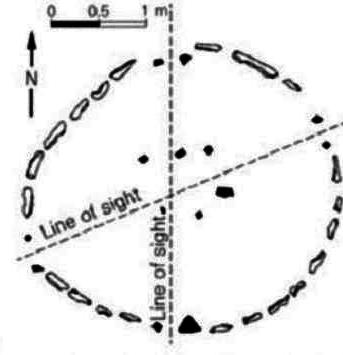
This section is very interesting, because the ratio between the major angle (110°) and the semi circle (180°) has a result very near to the golden ratio. Actually, 110 : 180 = 0,61111… while the golden ratio is 0,618033…, with a difference that is less than 7 thousandths. But as we have seen in the previous images, according to the CAD expert that measured the angles of the Circle relying on the images, the actual angles would not be 70° and 110°, but 69° and 111°. In this case we would have a ratio of 111° : 180° = 0,61666…, that’s to say a number that is different less than 1,5 thousands from the golden ratio. Actually, the golden ratio of the semi circle corresponds to 180° : 1,618033… = 111,24°, and so is very reasonable to hypothesize that the Nabta Playa Stone Circle could have been built in that point precisely because of astronomic motivations, that’s to say because in that position the sun crosses the North-South axis at the rises of the summer solstice (and so at the winter solstice too) with an angle very near to the golden ratio of the semi circle. Furthermore, modern astronomy informs us that with the passing of the millennia the angle of the solstices is subjected to little changes. So, it is not impossible that in the epoch in which Nabta Playa became a worship place (an epoch that does not necessarily corresponds to that in which the Circle was built, because other layers were found that testify how Nabta Playa was considered a sacred place various millennia before the alleged date of construction) the angle of the solstice matched in a perfect way with the golden ratio of the semi circle. This way, we can find a new possible association with Giza, were the roads to the valley temples are pointed to the fourth of intersection between the solstices and the equinoxes, with an angle equal to 14°: from this value we can derive that the angle between the two solstices is equal to 14° x 4 = 56°. This cipher seems interesting too, as it roughly corresponds to the golden ratio of the fourth of the circle, as 90° x 0,618033… = 55,62297, with a difference less than three tenth of one degree. But the surprises do not end here. In fact, if we take the angle of declination of Orion at its maximum at the meridian, that 58°14’ that is equal to the angle opposite to the major cathetus of a right-angle triangle constructed on the golden ratio and we divide it by the angle formed by the solstices, so to speak, with a numerological method, we find that 58,14 : 56 = 1,03821…, a number that appear anew very interesting. If from this number we subtract 1 and then we multiply it by 10 we have (1,03821… – 1) x 10 = 0,3821…, that’s to say a number almost identical to the reciprocal of the golden ratio, that is equal to 0,3819…, with a difference of less two thousandths. We can obtain a similar result with the subtraction between the fourth of the circle and the base angle of the Big Pyramid with the fraction of the degree expresses in hundredths, as 90° – 51.81° = 38,19°. If we divide this number by 100 we have anew the reciprocal of the golden ratio, that’s to say 0,3819, this time precise until the thousandth. Furthermore, the sine of the angle of 38,19° is equal to 0,6183: the difference with the golden ratio its about 3 thousandths.
7) Besides, a place like Giza could turn out very stimulating for a different kind of motivations too. For instance, Bauval says that at the summer solstice the sun reaches the culmination with an angle of declination equal to 64°: the difference with the fourth of the circle is equal to 90° – 64° = 26°, a value that is very near to the half of the base angle of the Big Pyramid and which of its descending and ascending corridors, that according with Bauval are more or less 26,50°. As Bauval says that the declination of the sun at the equinox is equal to 60° we can deduce that the declination at the opposite solstice should be more or less 56°. This angle, as we have already seen, matches perfectly with the angle formed by the two solstices and in an almost perfect way with the angle of declination of Orion at its maximum at the end of the ascending precessional semi cycle in the 2500 AC. It’s true that in all that ciphers we can find some approximations, but it’s very hard to negate that the system of these geometrical-astronomical connections turns out very fascinating, and it’s very difficult to think that all this could have come out for chance, especially thinking that the connections do not end here. In fact, if we turn to archaeoastronomical considerations of a more general kind, we can note that the angle of 28° that we find at Giza between the solstices and the equinoxes correspond in an approximated way to the angle of declination of the moon with the celestial equator at the moment of its peak, as we can see in the below image.

If we consider this cipher in a numerologic way, that’s to say excluding the decimals (as Ancient Egyptian did with the “normal” days of a solar year, that was considered 360, despite of the fact that they were aware that a solar year is 365,25 days), we find what we can call a perfect correspondence. Furthermore, to this point it’s almost due to note that the medium angle between the maximum and the minimum of the moon is equal to 23,5°, that’s to say to the angle between the terrestrial and the celestial pole, and that the difference between this medium point and the two extreme is equal to 5,1°, a number that turns out in an almost perfect way from π multiplied by Φ (that is equal to 5,083). Turning our attention to the precessional cycle, the fact that Vega become the polar star 16500 after Thuban, as we can note in the below image, could results interesting

Actually, in a cycle lasting about 26000 years, this fact means that the succession happens in a comparable way with the golden ratio, because 26000 x 0,618033 = 16068,858. It’s not impossible that Ancient Egyptians – that from an indeterminate number of millennia knew the phenomenon of the precession of the equinoxes – got convinced of the fundamental importance of the golden ratio from this kind of observations too. Furthermore, we have to note that – from a numerological point of view – the about 26000 years of precession could have something to do with the 51,817° of the base angle of the Big Pyramid. If we divide this number by 2 we see that 51,817 : 2 = 25,9085: curiously, it seems that the exact number of the precessional year would be 25920, a cipher really very near to which that comes out from the division of the base angle of the Big Pyramid. It’s true that numerologic considerations, from the point of view of the modern science, turn out ridiculous and, if they even survive, they are only a way to make jokes with numbers. Besides, the fact that to us a certain kind of connections turns out ridiculous does not mean that the same thing happened in cultures absolutely different from ours. In contrary, from the little that we know of the theological-astronomical thought of the Ancient Egyptians turns out that is very probable that also considerations of this kind made of Giza and other locations of the Ancient Egypt sacred places, dedicated to the worship of stellar goddesses, aside sun and moon.
8) At the end, the whole of these considerations drive us to think that places as Giza and Nabta Playa were considered sacred because of their astronomical relation with the cycle of the sun, associated with that of Orion. These heavenly objects was theologically described and understood by a geometry in which the golden ratio had a sacred and absolutely central meaning. As we have demonstrated in the previous article, that we published in this same site (THE GOLDEN NUMBER IN THE SACRED ANCIENT EGYPTIAN ART AND ARCHITECTURE: AN ARCHEOASTRONOMICAL PERSPECTVE), Ancient Egyptians discovered that the precession goes on with a “measure” connected with the golden ratio, just as it happens to the cycle of retrogradation of the nodes of the moon, another heavenly cycle that to an hermetic level had an enormous importance to them, maybe bigger than the solar one. Now, it turns out clear the reason why this people – to edify their sacred architecture – went searching points of the earth that was astronomically-geometrically “special”. Places like Giza and Nabta Playa was considered sacred and sacred buildings was edified there not because they had something particular from a geographical point of view or for some environmental characteristics, but because – used as astronomical points of observation – they could get relations between earth the Orion and the sun cycle, some way connected with the golden ratio, a cipher that was clearly considered divine, if not the image or the secret name of God itself, being seen as the fundamental measure by which the entire universe had been created and continuously regenerated.
APPENDIX: A BRIEF NOTE ABOUT THE THEOLOGICAL-ASTRONOMICAL MEANING OF THE CASTLERIGG AND STONEHENGE MEGALITHIC CIRCLES IN RELATION TO THAT OF NABTA PLAYA
1) Given the complexity of the issue, in this article we didn’t dwell on the fact – well known by archaeoastronomers – that in very distant places of the world there are megalithic sites characterized by a form very similar to which of Nabta Playa. Actually, if we take a glance at a very famous megalithic structure as Castlerigg Stone Circle (below images), we note that its inclination in relation to the North-South axis is practically identical to which of the terrestrial pole in relation to the celestial at the moment of the summer solstice, as another of its characteristic angles seems practically identical with the precession cone. So also this ancient structure too could have a relation with the computation of the precessional cycle, even if in a different way from that we have seen at Nabta Playa.
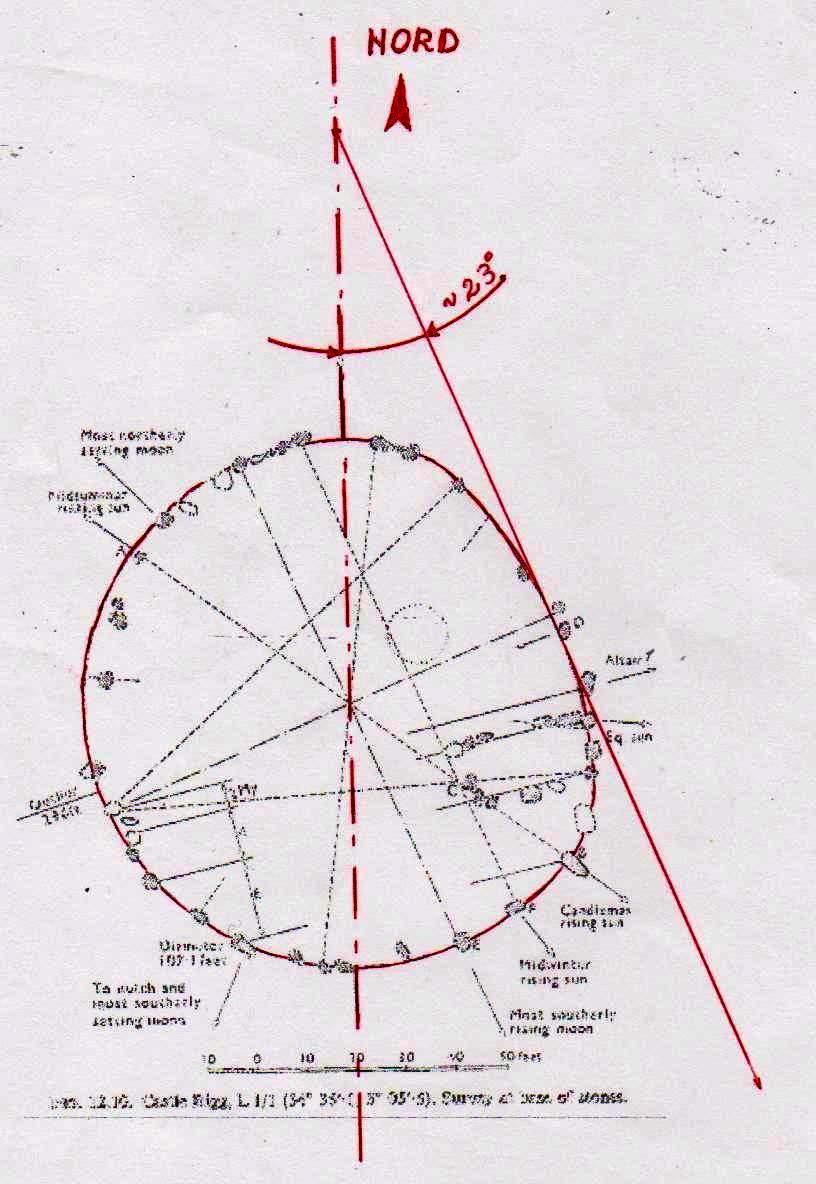

It seems that we can do a very similar reasoning about Callanish, Ggantija, Stonehenge and Avebury Hill too, while at Chaco Canyon the connection with the precession seems assured by a lunar angle, as we can argue from the below images.
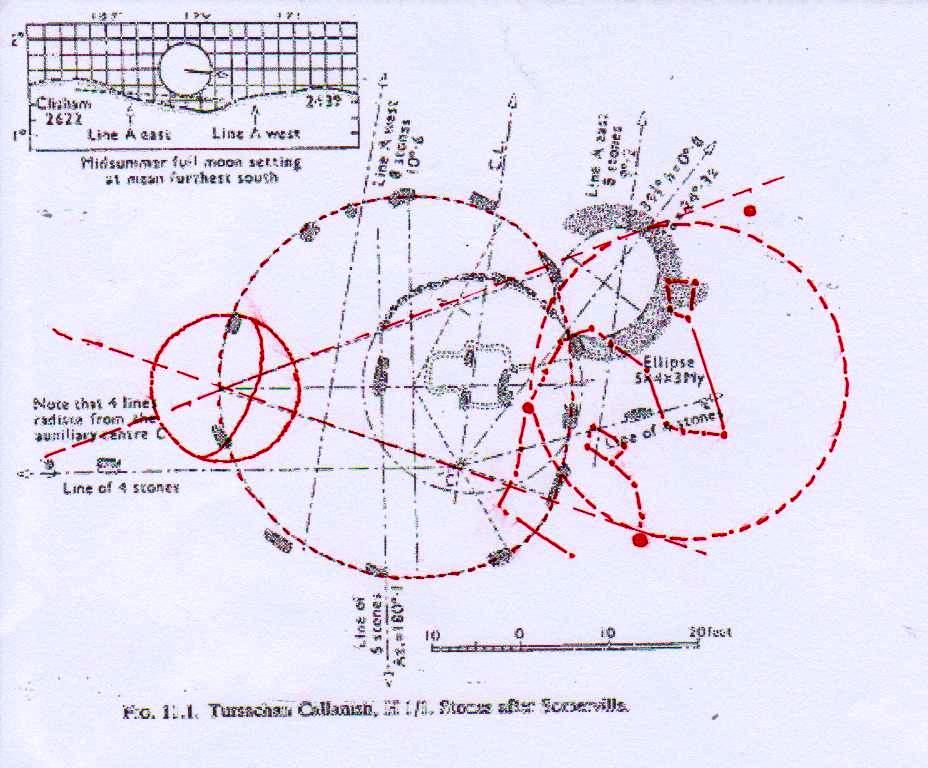

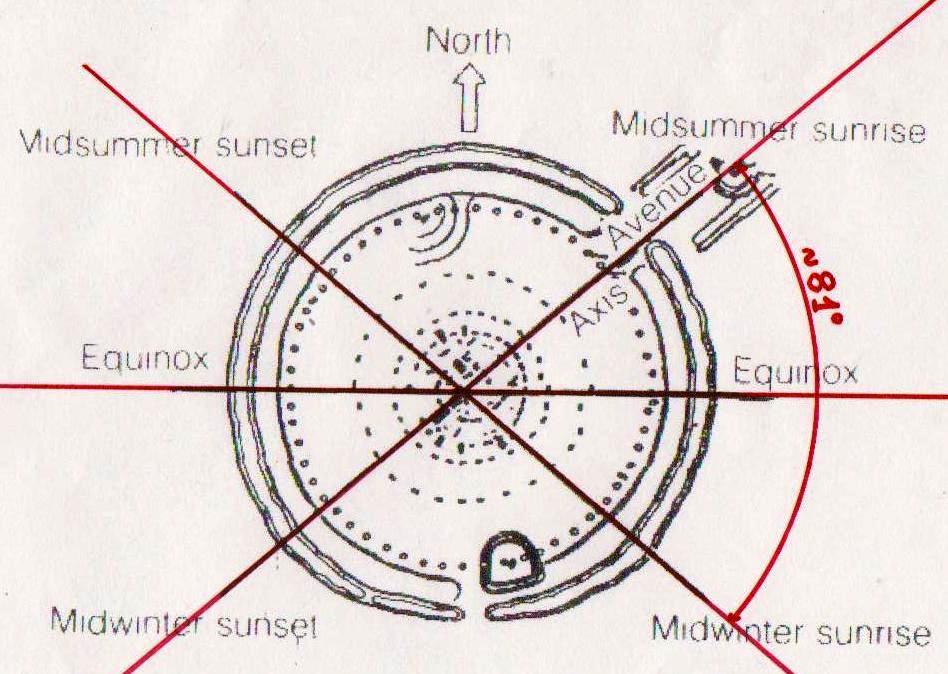

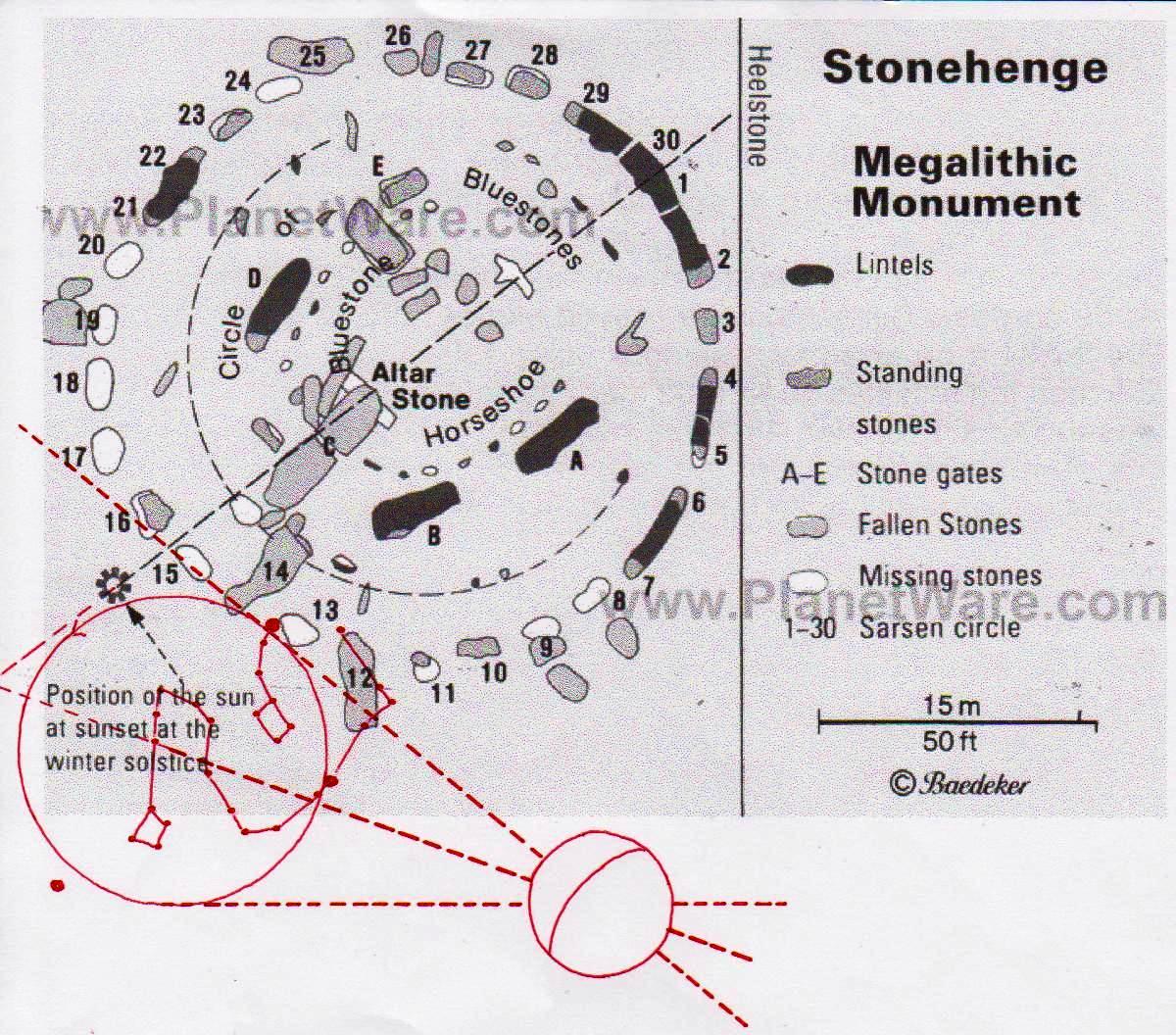
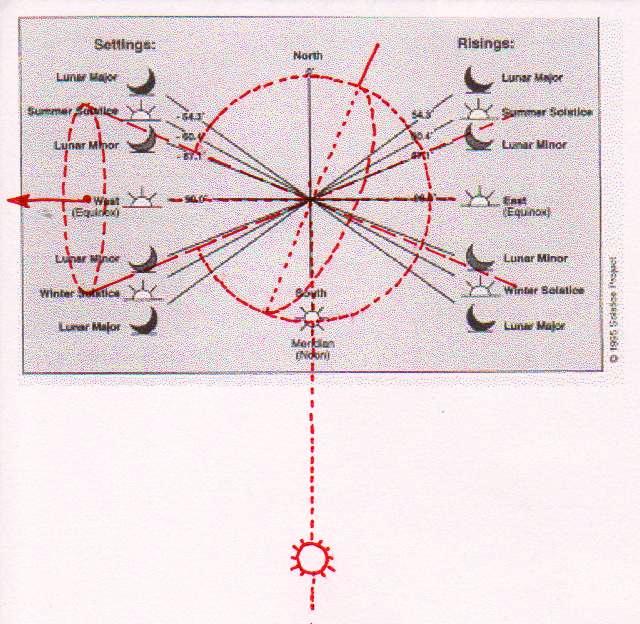
Talking about Stonehenge, it seems particularly interesting the angle between the two solstices, which is about 80-81 degrees. The two minor reciprocal angles on the semi circle turn out about 50°, that’s to say to the golden section of 81 : 1,618… = 50,06. Even with a passing reference, maybe it’s useful to note that the more or less 47° of the angle of precession, multiplied by the golden number are equal to 47 x 1,618… = 76,046°, an angle very near to that of the tip of the Big Pyramid. The reciprocal of the angle of precession on the fourth of the circle, multiplied by the golden number is equal to 43 x 1,618…= 69,574, an angle very near to which of the summer solstice rising at Nabta Playa.
2) Again in Great Britain, it was particularly discussed also the strange case of very ancient sites, lined up along hundredth of kilometers with an angle of 35° in relation to the East-West axis, as we can note from the below images.
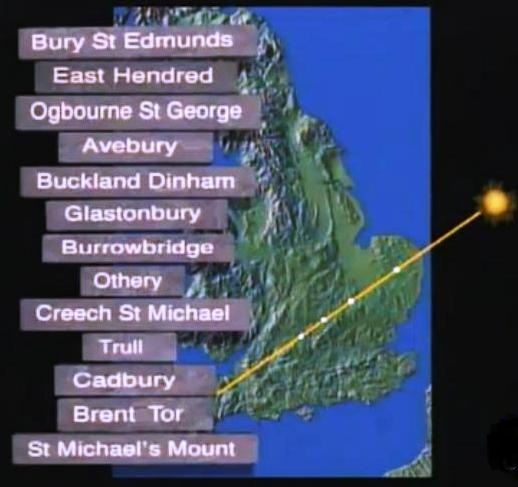
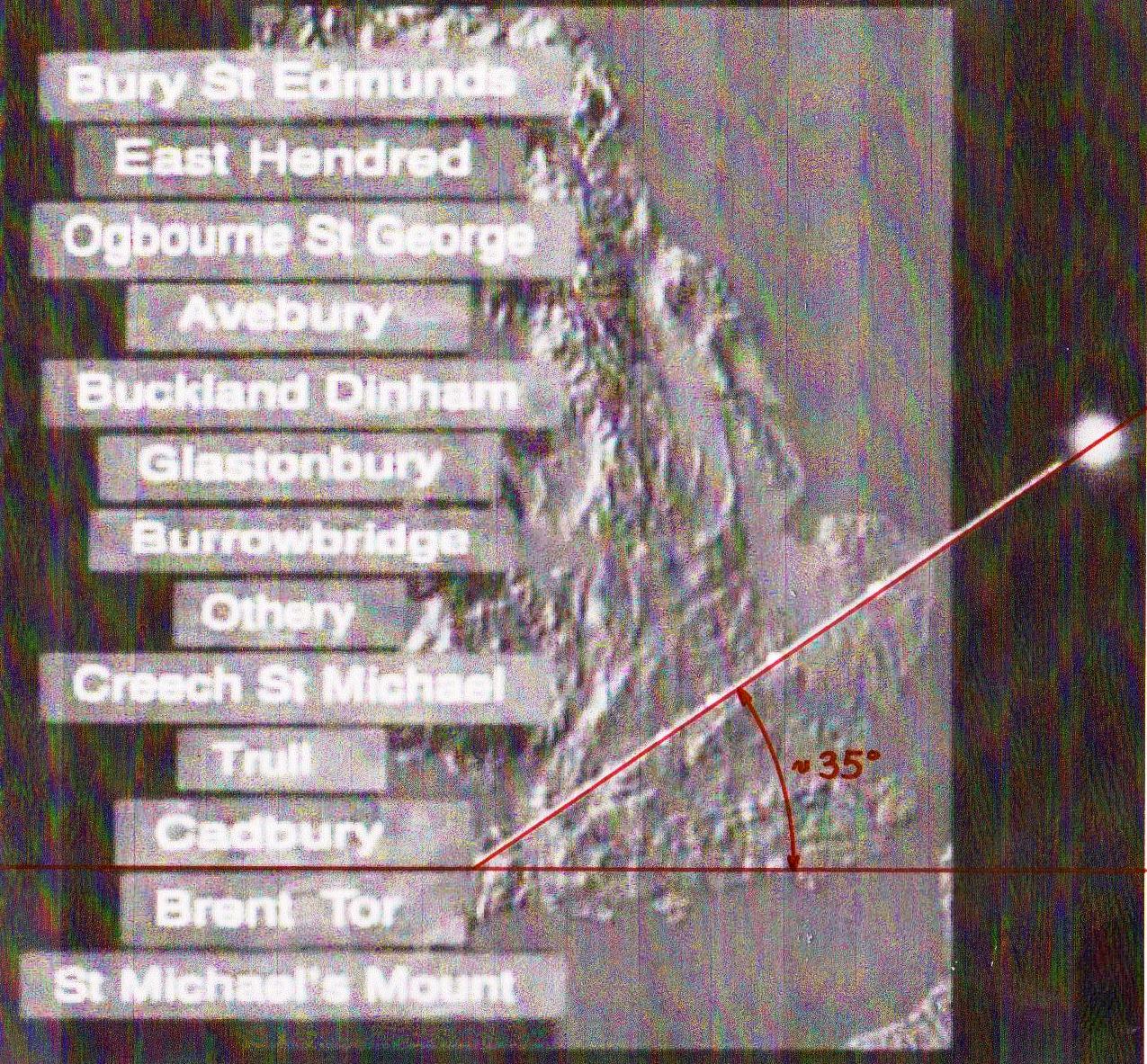
It is immediately evident the connection that this way turns out with the characteristic angle of the Nabta Playa Stone Circle, because in this case too we can find an angle of 70°, that which turns out with the connection with the axis of the rising sun in the opposite moment of the solar cycle. Subtracting this 70° to the 180° of the semi circle we find anew that golden ratio relation that we have seen at Nabta Playa, that’s to say 110° : 180° = 0,61111 (it’s useful to recall that in the pre- Columbian South America there are many sacred buildings oriented to 17,5° North-North-East: on the fourth of the circle what we could call the mathematical-numerological effects are the same). Remaining in Great Britain (images below), at Kintraw there is a characteristic angle of 97° in which we find other two sub-angles, one of about 58° and another of about 37°: an exact golden ratio sequence would be 97° : 1,618… = 59,94° : 1,618… = 37,05°. At the Klava Circles on the basis of the fourth of the circle we can construct the sequence 90°-54°-33°; the exact golden ratio sequence would be 90° : 1,618… = 55,62° : 1,618… = 34,37°.

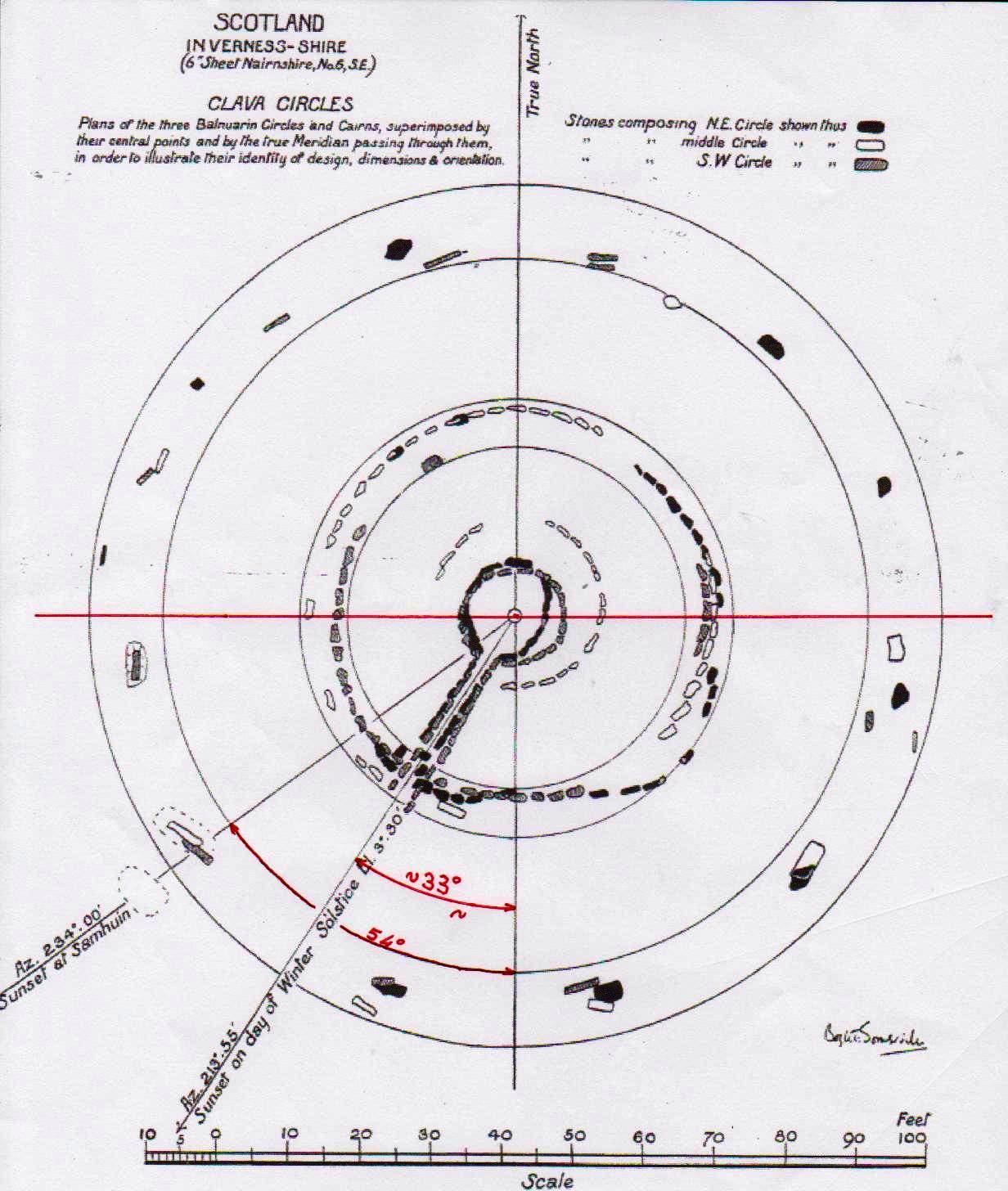
Instead, it we take the 80° of “opening” between the Stonehenge solstices and the 40° of Nabta Playa we can note that the relation turns out equal 80° : 40° = 2, while with the 56° of Giza the result of the proportion is 56° : 40° = 1,42857…, that’s to say equal to 10/7. The proportion between Nabta Playa and Giza is instead equal to 56° : 40° = 1,4, that’s to say equal to 7/5 (who knows, maybe it is more than a chance that 10/7 x 7/5 = 70/35 = 2). Instead, if we take the 35° of the angle formed by the sacred places of the South of the Great Britain and we divide it by the 28° of the summer solstice at Giza we note that the relation is 35° : 28° = 1,25, that to say equal to 5/4. What seems to emerge is a very ancient custom to place sacred buildings and structures of various kind following a system of geometrical-astronomical and numerological proportions about which it would be advisable to investigate in a deeper way.











































































































